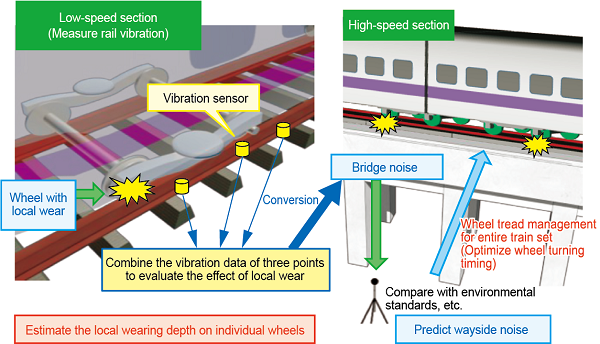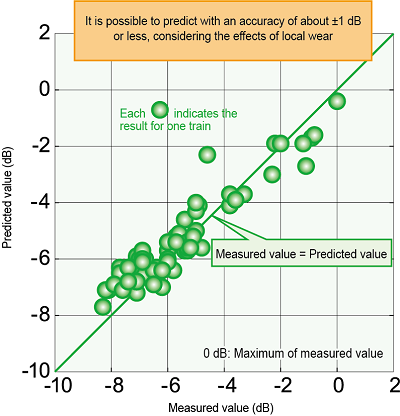19. Wheel tread management method based on wayside noise prediction
When local wear (small hollows occurring in the circumferential direction with a length of about 300 mm) occurs on the wheel treads of Shinkansen vehicles, the wayside noise may increase, mainly due to an increase in bridge noise. The amount of increase in wayside noise due to local wear is greatly affected not only by the local wearing depth of individual wheels, but also by the location and number of occurred local wears in the train set. In order to control the wayside noise below a certain level, it is desirable to have an efficient way to detect the wheel tread conditions of the entire train set. Therefore, we have constructed a method to estimate the local wearing depth of individual wheels from rail vibrations in low-speed sections where trains run at speeds of 100 km/h or less, and then to predict the wayside noise in high-speed sections where trains run at speeds of 200 km/h or more.
Since the position where the part with local wear of the wheel contacts the rail changes each time, the value detected by a single vibration sensor installed on the rail fluctuates greatly each time. Therefore, we have developed a method to accurately evaluate the effect of local wear on rail vibrations by combining rail vibration data from three points (Fig. 1). From the combined rail vibration, the local wearing depth of individual wheels can be estimated. In addition, we have extended the conventional method for predicting the wayside noise of Shinkansens to developed a new method to predict the wayside noise by reflecting the change in rail vibration of each bogie when the train passes through the low-speed section to the acoustic power level of the bridge noise in the high-speed section by each bogie (Fig. 1). The difference between the predicted value and the measured value of wayside noise was within about ±1 dB, demonstrating that it is possible to predict the noise when running in high-speed section from the rail vibrations when running in low-speed section (Fig. 2).
The results of the noise prediction in a high-speed section with this method show the condition of the wheel treads of the entire train set, and it can be utilized for wheel tread management such as the optimization of the wheel turning timing by comparing the results with environmental standards, etc.


